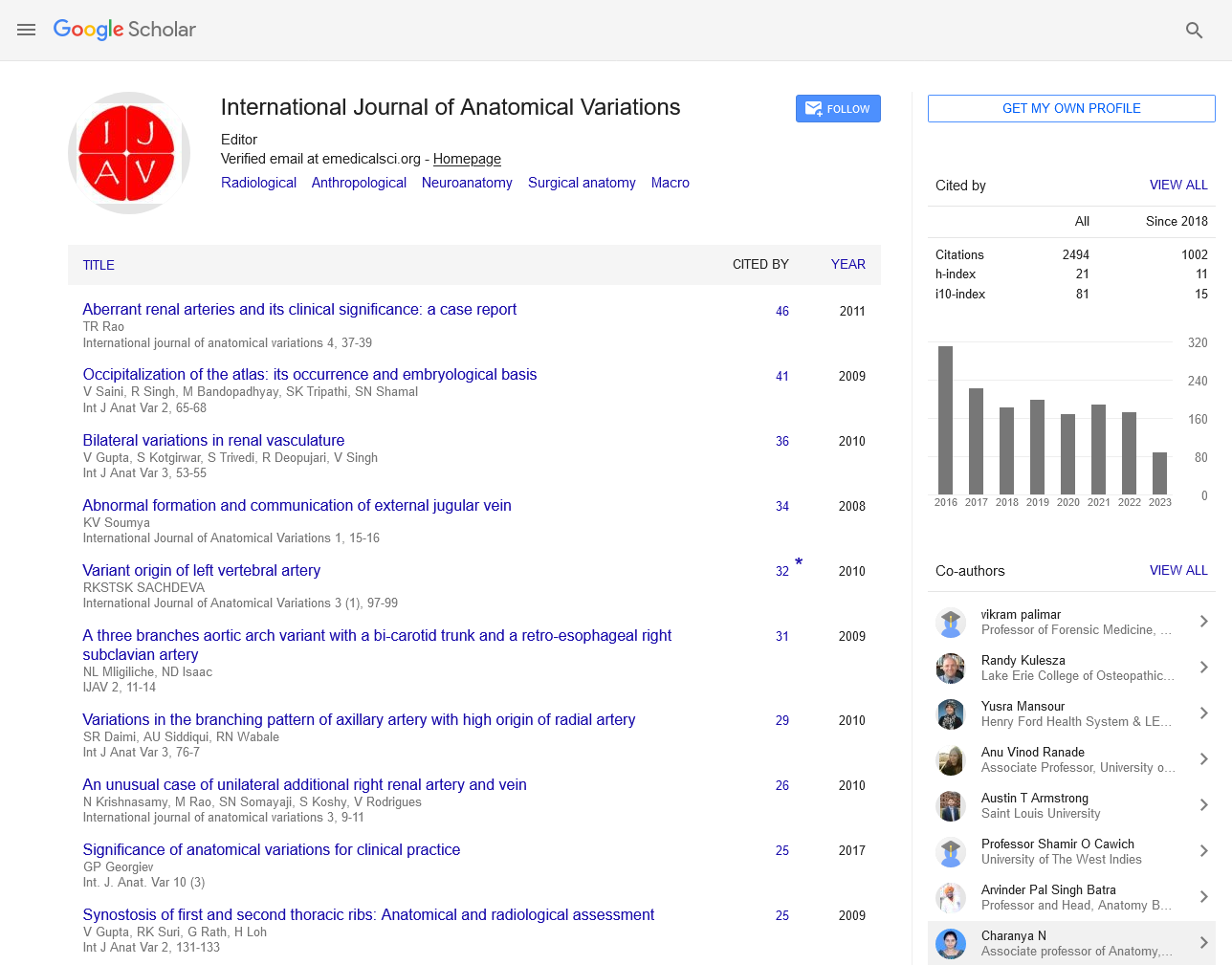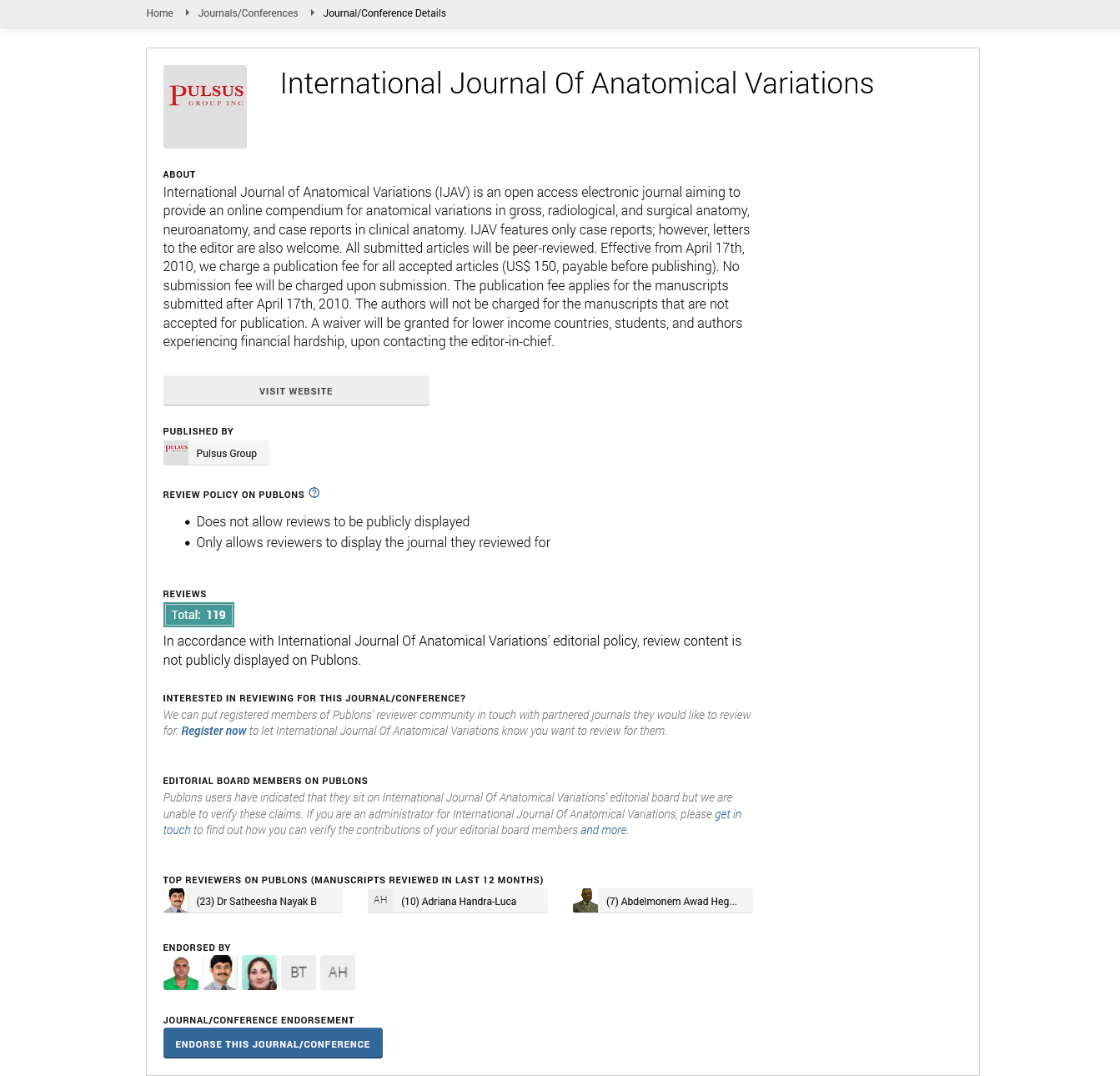Surface Anatomy Foundations Clinical Significance and Modern Applications
Received: 01-Apr-2025, Manuscript No. ijav-25-7675; Editor assigned: 04-Apr-2025, Pre QC No. ijav-25-7675 (PQ); Reviewed: 21-Apr-2025 QC No. ijav-25-7675; Revised: 26-Apr-2025, Manuscript No. ijav-25-7675 (R); Published: 30-Apr-2025, DOI: 10.37532/13084038.18(4).509
Citation: Nayak A. Surface Anatomy Foundations Clinical Significance and Modern Applications. Int J Anat Var. 2025; 18(4): 784-785.
This open-access article is distributed under the terms of the Creative Commons Attribution Non-Commercial License (CC BY-NC) (http://creativecommons.org/licenses/by-nc/4.0/), which permits reuse, distribution and reproduction of the article, provided that the original work is properly cited and the reuse is restricted to noncommercial purposes. For commercial reuse, contact reprints@pulsus.com
Abstract
Surface anatomy, the study of external anatomical landmarks as they relate to deeper structures, forms the basis of clinical examination, surgical planning, and medical education. This article provides a comprehensive overview of surface anatomy, including its historical evolution, anatomical regions, diagnostic relevance, and applications in contemporary medicine. With increasing reliance on non-invasive techniques and point-of-care assessments, surface anatomy remains a vital component of both foundational and clinical sciences.
INTRODUCTION
Surface anatomy, also known as superficial or topographic anatomy, is the branch of anatomy concerned with the study of external features of the body and their relationship to deeper internal structures [1]. It bridges gross anatomy with clinical practice, offering clinicians the ability to infer internal pathology through physical examination. Despite the advent of imaging technologies, surface anatomy continues to be indispensable in various medical and paramedical disciplines [2].
HISTORICAL BACKGROUND
The study of surface anatomy dates back to ancient civilizations. Early practitioners such as Hippocrates and Galen relied on visual and tactile assessments to diagnose diseases. During the Renaissance, anatomists like Andreas Vesalius advanced the understanding of the human form, mapping external landmarks to internal organs through detailed dissections. The 19th and 20th centuries saw the integration of surface anatomy into formal medical curricula, cementing its role in clinical education [3].
FUNDAMENTAL CONCEPTS
Surface anatomy is categorized into regions corresponding to major divisions of the body: head and neck, thorax, abdomen, pelvis, upper limbs, and lower limbs. **Anatomical landmarks** are palpable or visible points on the body that indicate the position of deeper structures. Examples include the sternum for locating the heart, the iliac crest for lumbar puncture, and the acromion for shoulder assessments. Lines such as the midclavicular, midaxillary, and anterior axillary lines, and planes like the mid-sagittal and transverse planes, help in systematically locating organs and performing physical assessments. **Palpation** is a cornerstone of physical diagnosis, allowing practitioners to assess organ size, detect masses, and localize pain. Techniques vary based on anatomical region and clinical context [4].
REGIONAL SURFACE ANATOMY
Includes surface features such as the zygomatic arch, external jugular vein, and carotid pulse. Knowledge of these structures is essential for procedures like intubation and cervical block anesthesia. Landmarks such as the sternal angle (angle of Louis), intercostal spaces, and nipple line are critical for cardiac and pulmonary assessments. The abdomen is divided into quadrants or regions using surface lines. Key landmarks include the umbilicus, McBurney’s point (for appendicitis), and the costal margin. Surface anatomy guides assessments and interventions, such as venipuncture at the cubital fossa or intramuscular injections in the gluteal region [5].
CLINICAL APPLICATIONS
Palpation, percussion, and auscultation rely heavily on surface landmarks. Rapid assessments such as FAST exams depend on surface-guided approaches. Precise incision sites and minimally invasive access depend on anatomical landmarks. Surface anatomy aids in muscular and joint assessments for therapy.
EDUCATIONAL IMPORTANCE
Surface anatomy is a foundational element of medical education, often taught through cadaveric dissection, prosection, 3D models, and simulation-based learning. It promotes spatial reasoning and clinical correlation, making it invaluable in early medical training.
TECHNOLOGICAL INTEGRATION
Modern tools like ultrasound, augmented reality (AR), and virtual dissection platforms have revolutionized the teaching and application of surface anatomy. Point-of-care ultrasound (POCUS) integrates surface anatomy with real-time visualization, enhancing diagnostic accuracy.
CHALLENGES AND FUTURE DIRECTIONS
Despite its importance, the teaching of surface anatomy faces challenges such as reduced cadaver access and curricular time. The future lies in blended learning approaches, combining traditional methods with digital innovations. Emphasis should be placed on maintaining clinical correlation throughout medical training.
CONCLUSION
Surface anatomy remains a vital component of medical science, deeply integrated into clinical practice and education. Its relevance persists in modern medicine, where a strong understanding of external landmarks continues to inform safe, accurate, and effective patient care.
REFERENCES
- Mamikonyan VR, Pivin EA, Krakhmaleva DA. Mechanisms of corneal neovascularization and modern options for its suppression. Vestn Oftalmo. 2016; 132(4):81-87.
- Gaigalaite V, Dementaviciene J, Vilimas A, Kalibatiene D. Association between the posterior part of the circle of Willis and vertebral artery hypoplasia. PLoS ONE. 2019; 14(9): e0213-226.
- Anri S, Masayoshi O, Shigeru H. Glomerular Neovascularization in Nondiabetic Renal Allograft Is Associated with Calcineurin Inhibitor Toxicity. Nephron. 2020; 144 Suppl 1:37-42.
- Mujagic S, Kozic D, Huseinagic H, Smajlovic D. Symmetry, asymmetry and hypoplasia of intracranial internal carotid artery on magnetic resonance angiography. Acta Med Acad. 2016; 45:1- 9.
- Rusu MC, Vrapclu AD, Lazar M. A rare variant of accessory cerebral artery. Surg Radiol Anat. 2023; 45(5):523-526.
Indexed at, Google Scholar, Crossref
Indexed at, Google Scholar, Crossref
Indexed at, Google Scholar, Crossref
Indexed at, Google Scholar, Crossref






